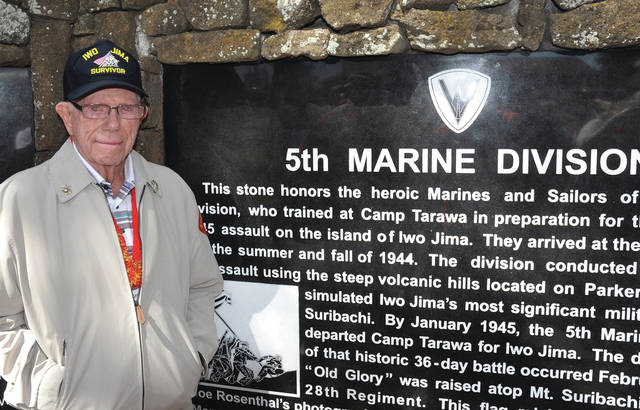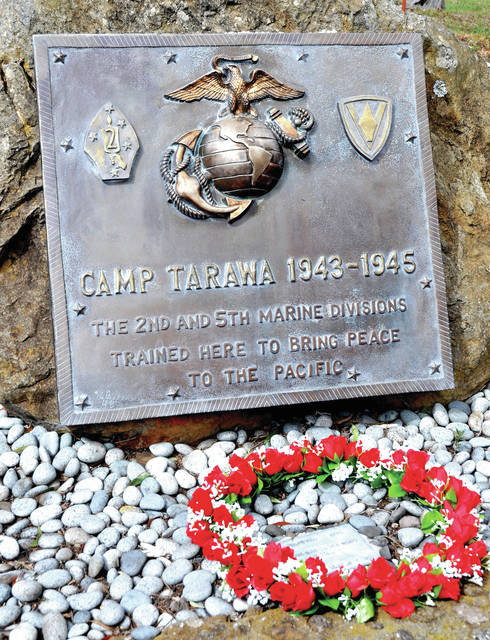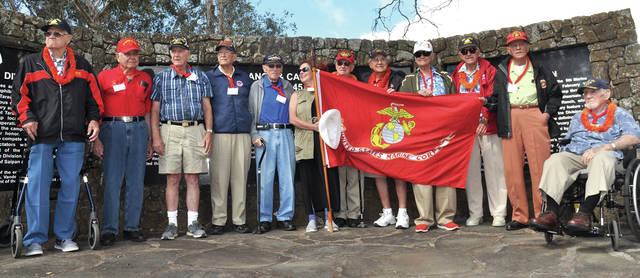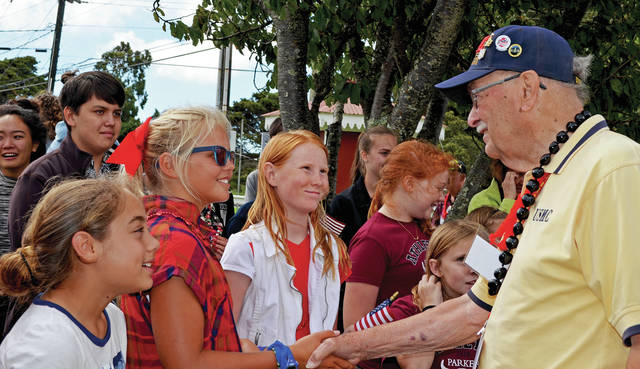The home of the brave: 15 Camp Tarawa vets reunite in Waimea

Vet Don Grave stands next to 5th Marine Division sign that marks what was once Camp Tarawa in Waimea during World War II. (GEORGE FULLER/SPECIAL TO WEST HAWAII TODAY)

A plaque at Camp Tarawa, near Parker Ranch headquarter’s entrance, pays tribute to the 2nd and 5th Marine Divisions who trained in Waimea between 1943 and 1945. (GEORGE FULLER/SPECIAL TO WEST HAWAII TODAY)

Eleven of the 15 veterans attending the reunion in Waimea last week assemble proudly at Camp Tarawa where they were once stationed. (GEORGE FULLER/SPECIAL TO WEST HAWAII TODAY)

Soldiers stationed in Waimea assemble on the front porch of the main Parker School building, their USO in 1943.

Parker School fifth-graders Kayle Rodrigues-Vincent, Mya Pinkert and Athena Kettner listen as one of the 15 veterans shares his experience on the same grounds where they now have class. (COURTESY PHOTOs/PARKER SCHOOL)
WAIMEA — Last Thursday, with trade winds howling, crowds of flag waving Parker School students lined the walkway as members of the 2nd and 5th Marine Divisions made their way to their school auditorium, shaking hands and telling stories along the way.
WAIMEA — Last Thursday, with trade winds howling, crowds of flag waving Parker School students lined the walkway as members of the 2nd and 5th Marine Divisions made their way to their school auditorium, shaking hands and telling stories along the way.
The men, accompanied by their families, were returning to the place that gave them a haven from the brutal battles taking place in the World War II Pacific Theater to remember a bustling community of openhearted generosity.
“I love this community. People are so friendly here,” 5th Marines Division member Donald Graves said.
In December 1943, after its victory on Tarawa Atoll, the 2nd Marine Division arrived in Hilo, making their way to Waimea on trucks across the saddle or on the sugar cane train up the Hamakua Coast. Camp Tarawa, a tent city, was soon erected despite the winds that coated their food with black grit and sand.
“You didn’t need salt and pepper,” said Carl de Haven.
Veterans, family, Waimea community members and Parker and Waimea Country School students gathered in the auditorium Thursday, where Kathy Painton, the reunion organizer, shared some World War II history in a slide show.
“My father was killed on Iwo Jima when I was 21 months, so all of you are my fathers,” she said.
Fallen Marines such as Silver Star recipient Harrydale Hyde from New Orleans were represented by family members. Sister Jimmie Hyde Watson remembers receiving the telegram.
“I was just 12 years old, sitting on the front porch when the telegram came,” she said.
The mic was then passed and stories unfolded. Born in Detroit, Graves told of making hot chocolate in a foxhole with the Japanese just yards away. He also remembered the amazing entertainment, such as the Ray Anthony and the Bob Crosby Orchestras that came to play for the Marines.
One of the many things the Marines did for fun was to visit the “slops shoot,” their name for the beer hall, where as well as refreshment they could find local entertainment.
“There was a dog that carried a tin can around in her teeth and she would go around and beg for beer,” said Frances Jackson, also from the 5th Marine Division.
The gathering ended with Philadelphia native Carl de Haven playing a rousing rendition of “The Marines’ Hymn” on his harmonica before lunch and more stories at Kahilu Town Hall.
All in their 90s, many of the vets signed up when they were 16 even though the legal age of enlistment was 17.
“I remember hearing Roosevelt’s speech on Dec. 8 and I still had six months to go to 17, but my parents signed the paper,” Graves said.
Now 94 and wheel-chair bound, John Coltrane was determined to return to Hawaii, even after a fall, rehab and much physical therapy. He and his wife Allene celebrated their 70th wedding anniversary with reunion attendees Thursday.
The geography of Waimea provided authentic training grounds for Pacific Theater battle zones, especially Iwo Jima.
“You see these small mountains? We invaded them. We had some good maneuvers here. We had planes drop over ruck sacks and we’d come and move in,” Graves remembered.
Where they were going was top secret, and when the division was one day out they brought out a clay model mountain and all the training made sense: they were going to Iwo Jima.
Jackson remembers the landing on Iwo Jima.
“I landed in the 13th wave and we were very fortunate. A shell hit in front of us and we jumped in that hole. The staff sergeant said to move and we looked up and there were no Japanese. I turned around and looked at the landing and the 14th wave got blown out of the water, the 15th wave got blown out of the water and the 16th wave got blown out of the water.”
That mission changed the course of Graves’ life.
“I had a flame thrower on my back and I put my face in the sand and said, ‘Lord if you get me out of this, I’ll serve you the rest of my life,’ and I’ve been in the ministry for 30 years. That’s my story.”
For other battle zones, such as Saipan with its extensive sugar production, the cane fields of Hamakua provided an ideal simulation.
However while the geography was ideal, the December Waimea weather proved a bit daunting for men just arriving from Tarawa, located in the tropical south Pacific. George Boutwell, of H&S Company in the 5th Medical Battalion, remembers that first drive across what’s now Saddle Road.
“I was driving a jeep and just had a t-shirt on. When we started to climb, it started to get kind of cool. We were in convoy and so I was driving with one hand and reaching back trying to get a jacket out of my pack.”
The reunion gatherings were subdued, yet magical as attendees gave the Waimea community a glimpse into its past. For a relatively short period of time, Waimea became a major hub for the war effort. People from all over the nation came together to form the 2nd and 5th Marine divisions, who in turn joined together with a small hard-working community to get the job done.
The reunion was a celebration of a legacy that connects generations and communities, giving students a firsthand glimpse at world history and the history of their community.
Or in the words of one Parker School student, “I think it’s cool we get to see this.”


